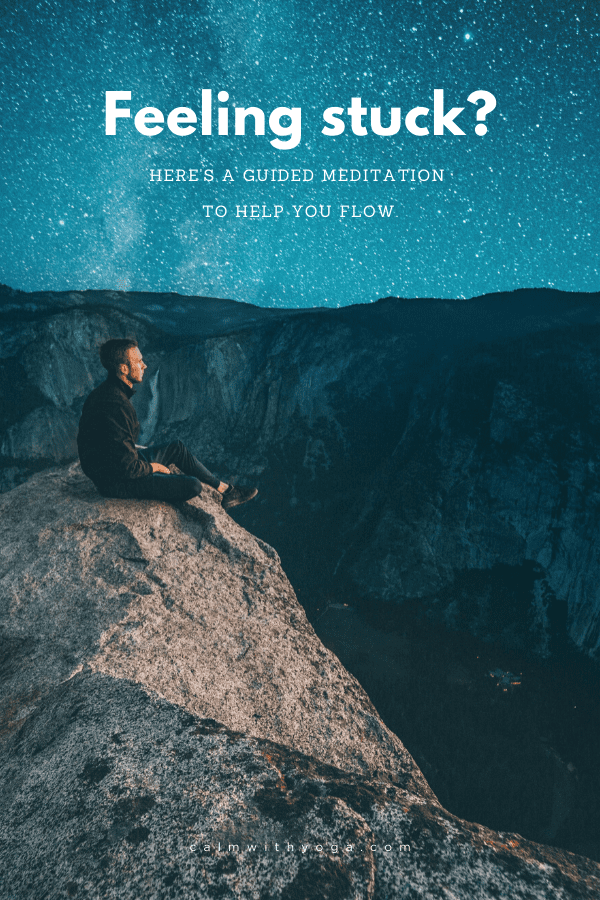You may not control all the events that happen to you, but you can decide not to be reduced by them.
-Maya Angelou, poet, activist, & educator
Whether it be in your personal life or at work, the truth of the matter is that none of us like experiencing ‘stuckness.’
On one hand, it’s not a fun or a comfortable place to be.
On the other hand,feeling stuckis the perfect place to be if you’re craving growth, expansion, and personal development.
It’s a space that’s full of potential because the more stuck you feel, the greater the opportunity to turn it around and change your life.
Feeling stuck in life can be the catalyst that busts us out of our comfort zone and helps us let go of limiting beliefs that keep us from seeing the ‘Bigger Picture’ of our story.
What’s on the other side of a rut?
New possibilities, new life lessons that bring deeper wisdom, positive changes, and ultimately a better life.
And it all starts with letting go of the belief that we’re not good enough or worthy enough to experience *big* shifts.
The truth is that more often than not we can’t control what happens in our outer world, but… we can control what happens in our inner world.
One effective way of doing this is by directing our attention to our energetic side.
According to yogic tradition we are made of energy and currents of energy are found in everything from the thoughts you think, the feelings you feel, where you invest your mental focus and awareness, and the air you breathe.
Energy is everywhere and we can learn to consciously tend to our own personal vital energy.
In doing so, we can effect change – changes in our perceptions about our circumstances and even possibly changes to our circumstances too.
When we shift our energy we shift our thinking and our beliefs…
When we shift our beliefs we shift how we show up in the world and how we respond to life.
You got this mama – you deserve to spend a few minutes practicing self-care.
Your 7 Main Energy Centers:
We have 7 main vital energy centers that run up and down the centerline of our bodies.
In the yogic world, they’re known as the chakras.
Chakras are the body’s energetic transformers.
They help regulate and transport vital energy to all systems that make up our entire body and mind.
According to yogic tradition, we have 7 main chakras:
Each chakra corresponds to an aspect:
1st chakra (root) – security/safety/ grounding
2nd chakra (sacral) – relationships/ sexual power/ creative power
3rd chakra (solar plexus) – personal power/self-esteem/ insight
4th chakra (heart) – love/ gratitude/ acceptance/ emotional mastery
5th chakra (throat) – communication/ speaking your truth/ self-expression
6th chakra (brow) – intuition/ foresight/perception/self-realization
7th chakra (crown) – spirituality/ union of the self/ union with the universe
If you’re feeling stuck you’re probably experiencing energy blockages.
An energy blockage is an imbalanced flow in energy.
When our chakras are open, balanced, and active we experience flow in our lives, our inner knowing and insight increases as does our creativity, and mental/emotional/physical health and wellbeing.
When our chakras are functioning optimally we feel an influx of vitality and we thrive.
When they’re closed, imbalanced, under or overactive we experience chronic emotions like frustration, anxiety, panic, irritation, fatigue, depression, anger, dread, etc.
When we have energy blockages in our own personal field we shrink and feel stuck.
If we learn to work with our personal energy field we can impact our physical experience too.
What determines if my energy is blocked or not?
By clearing chakras that are still locked into the conflicts of your past, you can open the way for healing chronic and underyling health problems.
– Donna Eden, author & energy medicine advocate
At any given time, your chakras embody different states.
For example, chakras can be either open or closed, balanced, underactive, or overactive.
A chakra’s state is determined by:
1) Thoughts:
Thoughts are a form of energy.
Thoughts cause the brain to light up creating tiny electric currents in different brain regions.
What are the thoughts that keep coming up for you over and over again?
Are the majority of your thoughts positive or negative?
2) Emotions:
It’s been said that emotions are energy in motion (e-motion) and this is quite fitting.
Each emotion has a corresponding vibrational frequency that either lifts us up or weighs us down.
Spending too much time feeling low-frequency emotions or not spending enough time in feeling high-frequency emotions creates the feeling of being stuck.
3) Mindful body movement (asana):
According to yogic philosophy, moving our bodies into specific different postures can stimulate energy flow through the chakras and can also help open up blocked or underactive chakras.
For example, wheel pose (Sanskrit name: chakrasana/ urdhva dhanurasana) is thought to stimulate all or most of the chakras as it provides a jolt of energy and deep backbend to the spine, where most of the chakras are located.
Wheel pose is also a powerful heart chakra opening asana.
Far more than making the body wheel-shaped, chakrasana can introduce our conscious awareness to the chakras—clusters of dormant energies that give chakrasana its name.
Eventually, using the power of breath, mind, and mantra, we attain a direct realization of the chakras and their latent energies.
In the esoteric tradition of hatha yoga, chakrasana creates a bridge between six chakras.
In the tradition of kundalini yoga, it bridges seven chakras…
-Sandra Anderson&Pandit Rajmani Tigunait for YogaInternational.com
4) Mental training/meditation (dharana/dhyana)
According topsychologist, scientist, & author of “Theories of the Chakras,”Dr. Hiroshi Motoyama, we can activate a chakra with one-pointed focus and mental concentration (dharana).
Since thoughts and mind are also a form of prana (energy), directing our intention and attention to specific chakras will actually help direct the flow of prana to that chakra.
In his studies, he found that there was a measurable increase in the activity of the heart chakra when subjects directed their awareness and internal feelings to that region. (1)
5. Breathwork (pranayama)
The nervous system can be compared to a huge power-generating center.
The brain and spinal cord can be seen as the generating station.
The nerves carry the electricity throughout the body.
If there is a good flow of electricity (i.e., energy or prana) and if the wires conducting the electricity are all strong, sturdy, and in good shape, everything runs well.
But if there is no adequate flow of energy or if the wires leading from the generator are damaged or there are loose connections, then the power system does not function optimally.
Through yoga practice, particularly pranayama, nerve centers are purified and stimulated, and the energy is channeled to optimal output and functioning.
– Swami Satchidananda, The Breath of Life: Integral Yoga Pranayama
Intentional conscious breathing is yet another effective way we can connect with and activate our energy centers so we can move stuck or blocked energy.
The yogic practice of pranayama (breathwork) literally means the ‘regulation of prana’ or the ‘regulation of vital energy.’
When you pair pranayama with dharana (mental focus) you create a powerful directive of energy throughout your entire being – mind, emotions, body, and energy.
All the more reason to practice the chakra activating meditation below…
It incorporates both pranayama and dharana.
Get unstuck and create more flow with this 10-minute chakra activating meditation:
Meditation is like a giant broom for sweeping away any stagnant or blocked energy that you may have buried deep in your body.
– Deborah King, author
For the next ten minutes, we’ll be using our breath and our mental focus to activate our personal energy field and strengthen it.
It’s time for you mama – find a quiet place and lock the door and get ready to journey inward.
Let’s practice together:
https://soundcloud.com/calmwithyoga/breathing-through-the-chakras-meditation
REFERENCES
:
(1) Theories of the Chakras: Bridge to Higher Consciousness, Dr. Hiroshi Motoyama




















